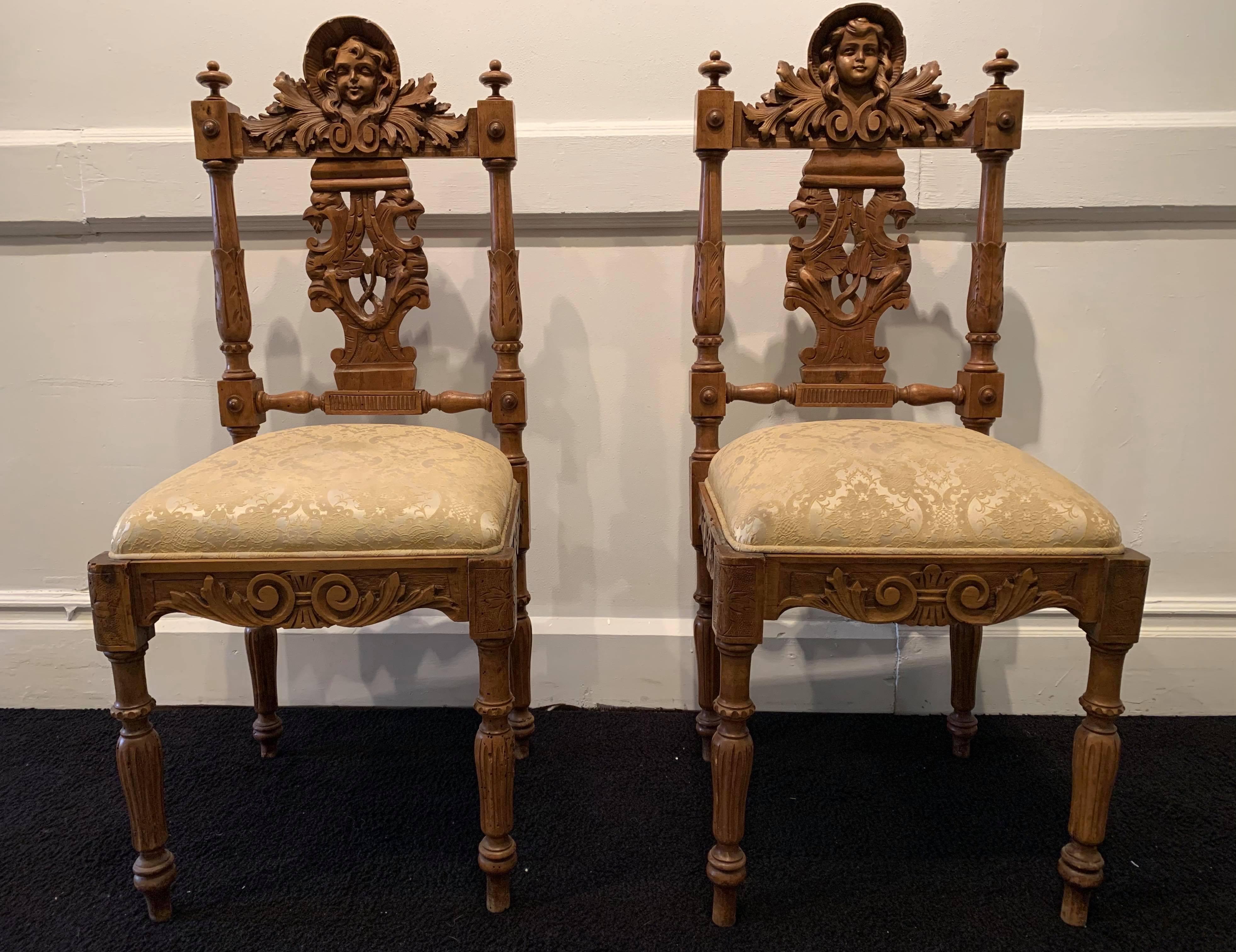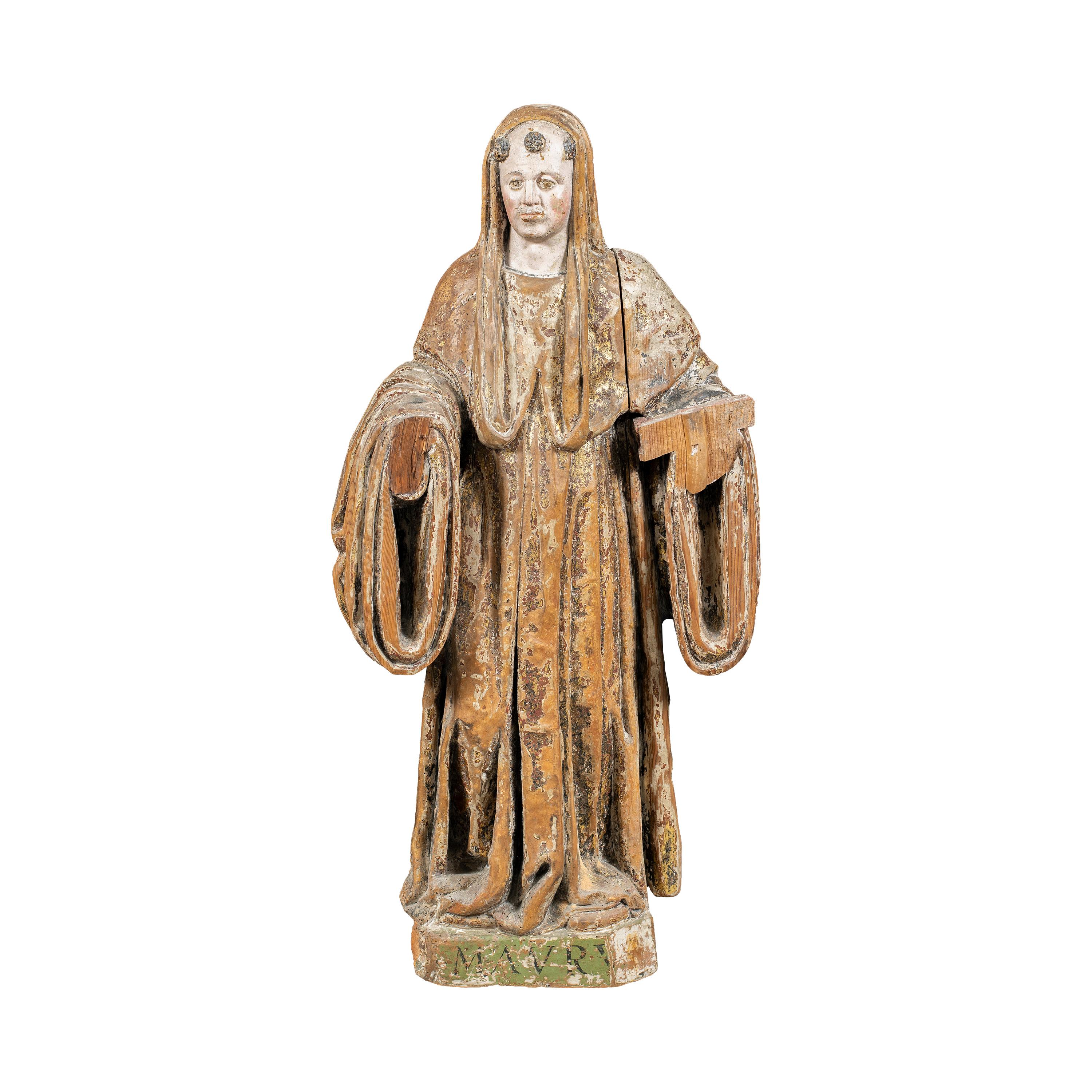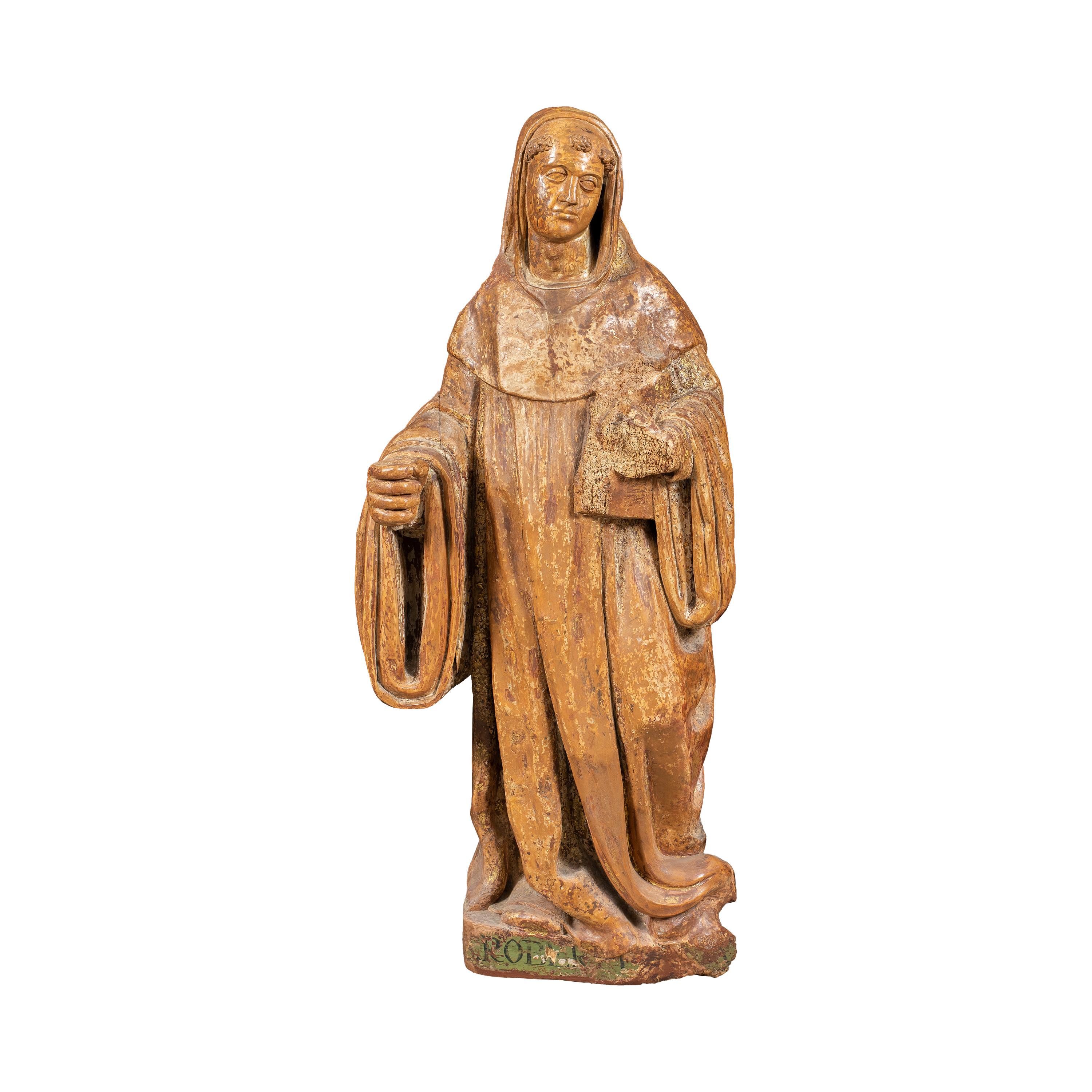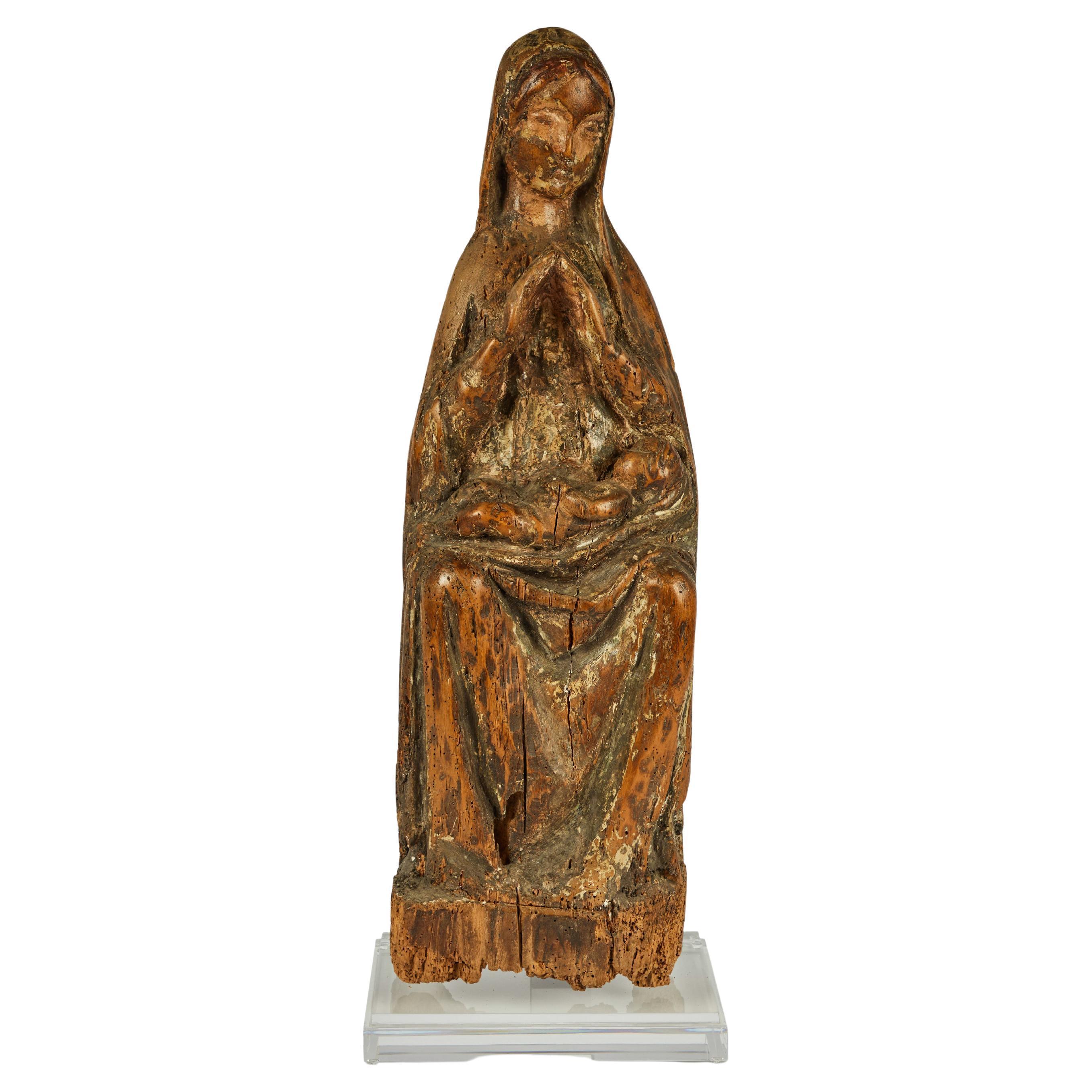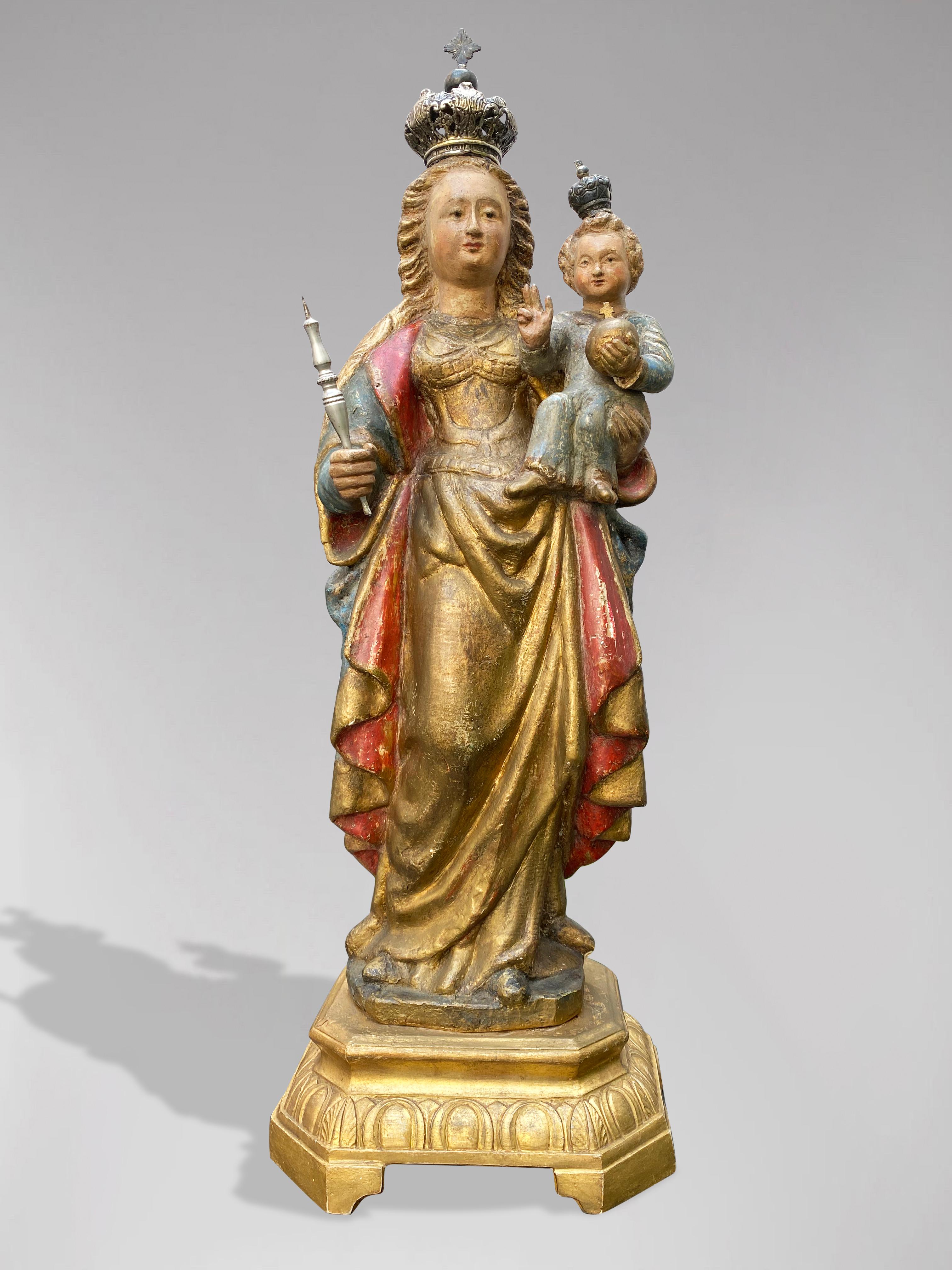Items Similar to A Spanish Statue of the Virgin Mary with Child Jezus, circa 1600
Video Loading
Want more images or videos?
Request additional images or videos from the seller
1 of 11
UnknownA Spanish Statue of the Virgin Mary with Child Jezus, circa 1600Circa 1600
Circa 1600
About the Item
Description: A Spanish Statue of the Virgin Mary with Child Jezus, Circa 1600, polychromed wood
Statue : Madonna and Child
Object Type: Statuette
Artist, Sculptor / Maker: Unknown
Place of Origin: Spain
Period: Circa 1600
Materials and Techniques: Polychromed wood
Categories: Christianity
Style: Renaissance
Dimensions: H. 45 cm D. 13 cm W. 15 cm
History:
The Madonna and Child is one of the most easily recognisable, most frequently produced themes in the history of Art and has been depicted by many famous artists, including Michelangelo, Leonardo da Vinci, and Raphael.
The word Madonna is derived from the Italian 'ma donna,' or 'my lady' and is used to describe Mary, the mother of Christ.
The Madonna and Child depict a loving mother and son, which is a symbol of hope, faith, and love and represents the love and bond between mother and child, and is a symbol of hope and protection.
Physical Description:
A magnificent statue in polychromed wood of standing Madonna and Child. Virgin Mary is holding Her Son in Her left arm. Together with Jesus Christ They are holding the World in Their hands to show that They are together and our Heavenly king on Earth and His Mother is our Queen.
She wears a tight fitting golden red dress; over this is a red mantle; Her mantle is lined blue and is with an ochre gold border. The flesh is painted in natural colours and Her long hair lies over both shoulders.
The Child Jesus wears a green long sleeves dress. With His right hand He gives a blessing and represents Trinitarian love. In addition to signifying a blessing or that the Lord is speaking, this position conveys doctrinal truth, the three uplifted fingers depict the unity of God in the Holy Trinity (Father, Son, and Holy Spirit).
Historical Significance:
The facial features and drapery which envelopes the body point to Spanish origin. The statue of Virgin Mary with Child Jesus is a rare specimen because of its physical condition and original retained colouring.
- Creation Year:Circa 1600
- Dimensions:Height: 17.72 in (45 cm)Width: 5.91 in (15 cm)Depth: 5.12 in (13 cm)
- Medium:
- Movement & Style:
- Period:
- Condition:The statue of Virgin Mary with Child Jesus is in good condition and preserved colouring. This work is offered in ready to collect gallery condition, having been professionally revised.
- Gallery Location:Bruges, BE
- Reference Number:1stDibs: LU2006212815022
About the Seller
5.0
Vetted Seller
These experienced sellers undergo a comprehensive evaluation by our team of in-house experts.
Established in 1998
1stDibs seller since 2022
14 sales on 1stDibs
Typical response time: 1 to 2 days
- ShippingRetrieving quote...Ships From: Bruges, Belgium
- Return PolicyA return for this item may be initiated within 14 days of delivery.
More From This SellerView All
- A Flemish Statue of Crowned Virgin Mary with Child Jesus, 17th CenturyLocated in Bruges, BEDescription: A Flemish Statue of Crowned Virgin Mary with Child Jesus, 17th Century, polychromed wood, silver crowns Statue: Crowned Madonna and Child Object Type: Statuette Artist, Sculptor / Creator: Unknown Place of Origin: Flanders Period: 17th Century Style: Renaissance Materials and Techniques: Polychromed wood, Silver Categories: Christianity Dimensions: H. 55 cm D. 15 cm W. 19 cm History: The Madonna and Child is one of the most easily recognisable, most frequently produced themes in the history of Art and has been depicted by many famous artists, including Michelangelo, Leonardo da Vinci, and Raphael. The word Madonna is derived from the Italian 'ma donna,' or 'my lady' and is used to describe Mary, the mother of Christ. The Madonna and Child depict a loving mother and son, which is a symbol of hope, faith, and love and represents the love and bond between mother and child, and is a symbol of hope and protection. Purity or virginity is represented by the color of clothing of Madonna. The color blue symbolises purity, virginity, and royalty. Physical Description: A magnificent 17th Century statue in polychromed wood of standing Madonna and Child. Virgin Mary is holding a small staff that is often shown in the hands of a king or queen. In Her left arm She is holding Her Son, Jesus Christ who is holding the World in His left hand to show that He is our Heavenly king on Earth and His Mother is our Queen. She wears a tight fitting golden dress with blue sleeves; over this is a blue mantle; Her mantle is lined red and is with an ochre gold border. The flesh is painted in natural colours and Her long hair lies over both shoulders. The Child Jesus wears a blue long sleeves dress...Category
17th Century Renaissance Figurative Sculptures
MaterialsWood
- A Spanish Statue of a Sitting on a Pedestal Angel with Open Arms, Early 19th CLocated in Bruges, BEDescription: A Spanish Statue of a Sitting on a Pedestal Angel with Open Arms in polychromed wood, Early 19th Century Statue: Statue of an Angel Object Type: Statuette Artist, Sculp...Category
Early 19th Century Baroque Figurative Sculptures
MaterialsWood
- A French Statue of Saint John the Baptist, Circa 1700, polychromed woodLocated in Bruges, BEDescription: A French Statue of Saint John the Baptist with Staff and Lamb on his Feet, Circa 1700, polychromed wood Statue: Shepherd with Lamb on his Feet Object Type: Religious St...Category
17th Century Baroque Figurative Sculptures
MaterialsPaint, Wood
- A Spanish Gothic Statue of Saint Mary Magdalene, Late 15th CenturyLocated in Bruges, BEDescription: A Spanish Gothic Statue of Saint Mary Magdalene, Late 15th Century, polychromed wood Statue: Saint Mary Magdalene Object Type: Statuet...Category
15th Century and Earlier Gothic Figurative Sculptures
MaterialsWood
- Gustave Jean Jacquet, Paris 1846 – 1909, French Painter, 'La Belle en Bleu'By Gustave Jean JacquetLocated in Bruges, BEGustave Jean Jacquet Paris 1846 – 1909 French Painter 'La Belle en Bleu' Signature: Signed middle right Medium: Pastel on paper mounted on canvas Dimensions: Image size 46 x 38 cm, ...Category
Late 19th Century Realist Portrait Paintings
MaterialsCanvas, Pastel
- Hubert Malfait, 1898 – 1971, Belgian Painter, 'Sitting Nude', Signed top leftLocated in Bruges, BEHubert Malfait Astene 1898 – 1971 Sint-Martens-Latem Belgian Painter 'Sitting Nude' Signature: Signed top left Medium: Oil on canvas Dimensions: Image size 90 x 60 cm, frame size 114 x 84 cm Biography: Malfait Hubert was a Belgian painter who belonged to the third Latem School. He was born in 1898 in Astene, Belgium, as the son of the local municipal secretary Jules Malfait. Growing up amidst influential figures like Emile Claus, Valerius De Saedeleer, and Albijn Van den Abeele, who were friends of his father, Malfait developed an early affinity for art. During the war years, he studied at the Gent Academy of Fine Arts alongside Jules De Sutter. A pivotal moment in Malfait's career occurred in 1924 during the exhibition "Laethemsche Kunstenaarskolonie," where he met critics André De Ridder, Paul-Gustave van Hecke, and Georges Marlier. This led him to become an integral part of the avant-garde expressionist group around Gustave De Smet, Frits Van den Berghe, and Constant Permeke. Progressive Brussels galleries strongly supported him, considering him the flagbearer of a new generation of expressionists. Despite economic challenges and the bankruptcy of Le Centaure, Malfait's primary supporter, in 1932, he continued to shape the Brussels art scene. Emmanuel de Bom defended him, asserting the vitality of expressionism. Malfait reemerged in 1934 with an exhibition at Galerie Louis Manteau. In the 1930s, Malfait was a prominent figure in the Gent art scene, showcasing his works at venues like Ars and later at Galerie Vyncke-van Eyck. The economic crisis and Le Centaure's bankruptcy affected Malfait, but he resurged in 1934 with an exhibition at Galerie Louis Manteau. The war years marked a shift in Malfait's exhibitions, with major solo shows occurring in 1944. He exhibited paintings in Galerie Brueghel and drawings in Galerie Apollo. The Museum voor Schone Kunsten in Oostende organized an extensive retrospective just before his death in 1971. Malfait's artistic evolution saw him transition from impressionism to expressionism, influenced by Eugène Laermans and Jakob Smits...Category
Early 20th Century Expressionist Nude Paintings
MaterialsOil, Canvas
You May Also Like
- 19th Century Pair of Hand-Carved Hall Chairs from MexicoLocated in Troy, NYThese 19th Century hand-carved hall chairs from Mexico are reminiscent of a Renaissance style in the design of the faces of the angels and ornamentation. This native wood is walnut colored with a stain that gives the chairs a caramel glow. The cushions are upholstered in a, light yellow silk brocade fabric. There are pin-sized holes from an earlier exposure to termites, a desirable element in antique Mexican furniture...Category
19th Century Renaissance More Art
MaterialsFabric, Wood, Mixed Media
- 16th century Italian carved wood sculpture - Saint Mauritius - Gilded PaintedLocated in Varmo, ITCarved wooden sculpture - San Mauro. Italy, 16th century. 54 x 30 x h 110 cm. Entirely in carved and painted wood with traces of polychromy and gilding. - Work registered at the b...Category
16th Century Renaissance Figurative Sculptures
MaterialsWood
- 16th century Italian carved wood sculpture - Saint Robert - Gilded PaintedLocated in Varmo, ITCarved wooden sculpture - San Roberto. Italy, 16th century. 54 x 30 x h 112 cm. Entirely in carved and painted wood with traces of polychromy and gilding. - Work registered at the...Category
16th Century Renaissance Figurative Sculptures
MaterialsWood
- Early Renaissance Wood SculptureLocated in Newport Beach, CAAn evocative, 14th century, carved wood statue of a seated Mary with the Christ child in her lap. The piece with a beautiful patina featuring polychrome paint traces. Now mounted on ...Category
15th Century and Earlier Renaissance Figurative Sculptures
MaterialsWood, Paint
- St CeciliaLocated in London, GBD. BRUCCIANI & CO (19th Century) St Cecilia Polychrome painted plaster bust with mould lines visible (probably later painting) 47 cm., 18 ½ in. high Dom...Category
1870s Renaissance Figurative Sculptures
MaterialsPlaster
- ANTIQUE ITALIAN RENAISSANCE IONIC MARBLE CAPITAL WITH PUTTI, 16TH CENTURYLocated in Milan, ITFinely carved male capital dated from the 16th Century. Created in Italy, this fine works features the faces of winged cherubs.Category
16th Century Renaissance Figurative Sculptures
MaterialsMarble
Recently Viewed
View AllMore Ways To Browse
Antique Statue Art Sculptures
Makers To The Queen
The Virgin Mary
Antique Wood Statue
Antique Wood Statues
Antique Red Dress
Spanish Antique Sculpture
Circa 1600
Wood Virgin
Red Statues
Mother And Child Wood
Blue Statues
Mary Jesus
Jesus And Mary
Virgin Child
The Virgin And The Child
Antique Virgin Mary
Italian Renaissance Style Art
